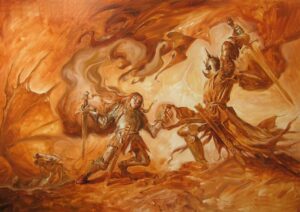I had the pleasure of the opportunity to attend Illuxcon 2011 last week, and one of the highlights for me was the chance to watch a painting demostration from Petar Meseldzija in person. Petar spoke on the value of emotional content in your work and then gave a whopping 3 hours demo where he attemtped to paint a folk tale-esque countryside scene for a new book. He stated that he was not entirely happy with the result however, the demostration itself was a huge success from my point of view in that it showed many insights into Petar process. One important piece that cannot be underestimate is the power of Petar’s underpainting. In this example of Eowyn and the Lord of the Nazgul, you can see the level and finish of his underpaintings. If you check out his personal blog you will find the exact colors that he uses, but what I think is more important is that he does not use a single color like burnt umber for his entire underpainting. He uses variation of monochrome, both warm and cool. For example, many of us use burnt sienna and raw umber. Burnt sienna is a very warm orangy brown, where raw umber is a much cooler almost bluish brown. This combination of monochromatic tones enables the underpainting to begin to exhibit characteristics which helps define form as well as create depth as well as begins to expose what color relationships should be setup moving forward. And like a Norman Rockwell painting that I once noticed all the light leaks showing through, Petar allows portion of the his underpainting to show through in order to add depth, increase tonal qualities and in some cases, simply allows it to bleed through to fill “light leak” holes in areas where he hasn’t push paint into. The way he paints, he seems to obliterate parts of the image with his brush strokes and uses the underpainting in part to help reel the image back in as he moves the paint over the canvas (or panel). It still boggles my mind how beautifully craft his simple underpaintings are.
